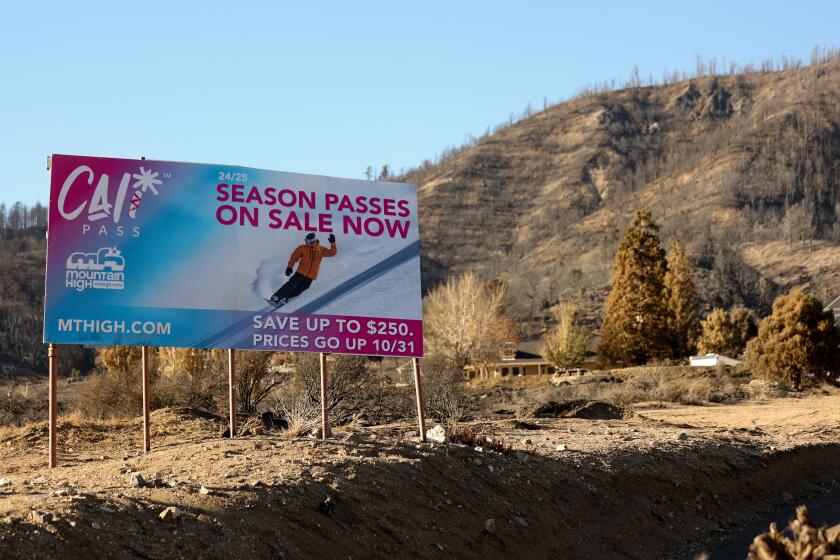
CAMARILLO, Calif. — Stanley Jensen worked with firefighters to break open a melted safe amid the rubble of his family’s home.
As Jensen used a window screen to sift the safe’s ashen contents for diamonds and stones, his wife, Dawn DaMart, wandered the blackened foundation searching for tokens of the couple’s life before the Mountain fire.
“Grammy, I made that for you,” her granddaughter Violet called out, pointing in the ash. DaMart picked up a clay butterfly sculpture engraved with the 11-year-old’s name.

Meanwhile, DaMart’s longtime friend Pamela O’Kane, who lives in Thousand Oaks, surveyed the scene in disbelief: Not more than a few hundred feet away, other homes stood virtually unscathed.
“How can it just stop? How, when there are sparks flying everywhere?” O’Kane said. “Random — that’s the word I’m looking for. … It is truly random.”
It’s a question many are now asking in Las Posas Estates and Camarillo Heights — two affluent communities nestled against the foothills of the Santa Susana mountains and dangerously close to a flammable, brush-dominated ecosystem.
Residents in the foothills above Camarillo are grappling with scenes of staggering destruction after the Mountain fire flattened scores of homes.
Some houses, seemingly scattered at random, were reduced to rubble with only a lifeless moonscape left behind. Others, sometimes next door, were almost entirely unaffected — some still with lush green lawns.

Yet as urban and suburban sprawl continues to push communities further into fire-prone landscapes and climate change continues to worsen blazes, scientists and fire experts are fiercely debating what control homeowners really have over whether their home survives — or if it simply comes down to chance.
Recently, neighbors gathered on the street for the first time since fire ravaged their homes. As firefighters patrolled the area for hot spots and helped grieving residents, neighbors retold their stories of the nightmarish day.
The night before the fire exploded, the eerie howl of the Santa Ana winds kept some awake. The next morning, the winds kicked up dust from nearby farms and orchards, obscuring the community’s panoramic views of Camarillo and the Pacific.
The winds were so strong that Ken and Pamella McWaid, who live a few homes down from Jensen, watched their large window bowing in and out.
By midmorning, news made it to the neighborhood that a fire had broken out about 11 miles away. Many — who have had several close calls with wildfire before — knew instantly that this could spell disaster.

Contrary to popular belief, the most destructive force in most Southern California wildfires isn’t the flames — it’s the embers. As fires devour flammable brush and vegetation, the heat propels burning embers upward. Strong winds can carry them for miles.
When they land, they risk igniting new spot fires, which can quickly devour homes.
“The great majority of homes that burn in wildfires are already in flaming ruins by the time the fire reaches the town,” said Chad Hanson, a wildfire scientist and the director and principal ecologist at the John Muir Project.
Within minutes, this worst-case scenario became a reality in Las Posas Estates.
The McWaids watched in horror as flames jumped up the canyon and into their backyard, without warning.
In just a few terrifying hours, the Mountain Fire became the most destructive blaze in Southern California in years. The conditions were ripe for disaster, and neighborhoods had few defenses. Here is what happened.
Ravines — which line both sides of the winding roads in Las Posas Estates and Camarillo Heights — are particularly dangerous, said Kyle Ferris, fire behavior analyst with the Mountain Incident Command Team.
Once an ember ignites vegetation near the bottom, the flames can quickly scale both sides and rising heat dries out the vegetation ahead, practically clearing a path for the fire to race through.

The McWaids rushed to the garage, but as Ken McWaid opened the garage door, thick black smoke billowed in and hot embers singed his skin. As his wife, Pamella, started driving, he quickly yanked the garage door back down.
Ken McWaid raced out the front door to his work truck and followed his wife.
Another neighbor drove her car directly through Jensen’s property to escape the inferno, which had already blocked off the sole escape route.
Camarillo sits in a chaparral ecosystem — one dominated by dry fire-loving brush that, as a natural part of the ecosystem’s life cycle, routinely burns.
Whether communities like Las Posas Estates and Camarillo Heights can truly beat fire in such an environment, though, remains a topic of fierce debate among scientists.
Some fire researchers say taking simple steps to clear yards, roofs and gutters of flammable vegetation and ensuring there is absolutely no opening for embers to get inside — whether a dog door, a vent or an open window — can virtually fireproof a home.

“It’s not 100% effective, but it’s pretty damn close,” Hanson said. But to be effective, there cannot be any weak link in the defense.
“As far as I know, there’s always an explanation [for a house burning down] if people look closely enough,” he said. “I’m not aware of exceptions.”
Yet others say there is no way to guarantee safety — especially in extremely dry and windy conditions.
In a case like the Mountain fire, “It truly is random,” said Ferris, the fire analyst, “when you have the fires moving this fast and the amount of the embers it casts going everywhere and the size of the embers too.”
Amid explosions and darkened skies, the crew at Mountain High ski resort jumped into action, firing up a hundred snow cannons to douse the flames with water.
Alexandra Syphard — one of the first researchers to study the effectiveness of home hardening and defensible space in real wildfires in the early 2010s — said it’s somewhere in the middle.
“It’s neither” pure chance which homes burn nor completely determined by which home hardening measures were taken, she said. “Doing things to your house — in particular things like vent screens, or closing eaves on your roof or having double-pane windows — can significantly increase the chance that your house survives a fire, but contrary to what a lot of people like to say, this is not a guarantee.”
A 2019 study by Syphard attempted to quantify the degree to which home hardening measures actually protected homes against fire by analyzing more than 40,000 structures that faced wildfires from 2013 to 2018 — a period that included the devastating Camp and Woolsey fires.
The results varied widely from region to region, but in Southern California, homes protected by a fire department were 19% less likely to burn — 31% if a civilian helped defend it too. Multipaned windows reduced the risk of the home burning to the ground by 26%.
Other measures did little to save houses — such as clearing nearby flammable vegetation beyond 15 feet around the house, which, at best, reduced the risk by 3%.

Another independent study found that both hardening the home and clearing nearby spaces of flammable brush cut the chance of destruction in half — from 40% chance to 20%.
The Camarillo area has limited resources dedicated to home hardening and defensible space management education and home-specific consultation visits. Right now, the Ventura Regional Fire Safe Council bears most of the responsibility.
“We are — I guess fortunately and unfortunately — the biggest player in the county,” said Stephen Watson, the executive director of the council.
With only eight employees, they have yet to reach most residents.
Nevertheless, the McWaids had done their homework.

“They want you to have 100 feet from your house back. … We had all that cleared,” Ken McWaid said.
“We were always thinking fire,” he said. “You see these people and they go, ‘Why do they live in the brush?’ Well, you know, all of that was dirt. It was all cleared.”
Yet, by the time the McWaids were rushing away — with 20- to 25-foot flames in the rearview mirror, right up against the area that they had cleared — McWaid was already certain his home was doomed.
“As I was backing out, then I could see it,” McWaid said. With embers flying everywhere and hitting the house, “I knew it was done.”
Syphard worries that a perception that home hardening is meaningless could result in residents not taking key steps to prepare their homes. Meanwhile, a belief that home hardening is a silver bullet could incentivize cities and residents to keep building in dangerous, wildfire-prone regions.
“If you assume that all home modifications are effective, you’re creating a false sense of security,” she said. “Other studies I’ve done have found that the most important factor that explains why a structure is destroyed in a fire is the location of the house.”
Both DaMart and the McWaids say they plan to rebuild.
Pamella McWaid, a real estate agent of 30 years, had sold many of her Las Posas Estates neighbors their homes, including many now reduced to ash. One couple had moved in just three weeks ago.
The view and sense of community are simply too hard to beat, they say.

“My wife … she found this house, but we bought it because of that,” said Ken McWaid, gesturing at the view of Camarillo. “We really enjoy this community.”
But there’s no guarantee a blaze like the Mountain fire won’t happen again.










